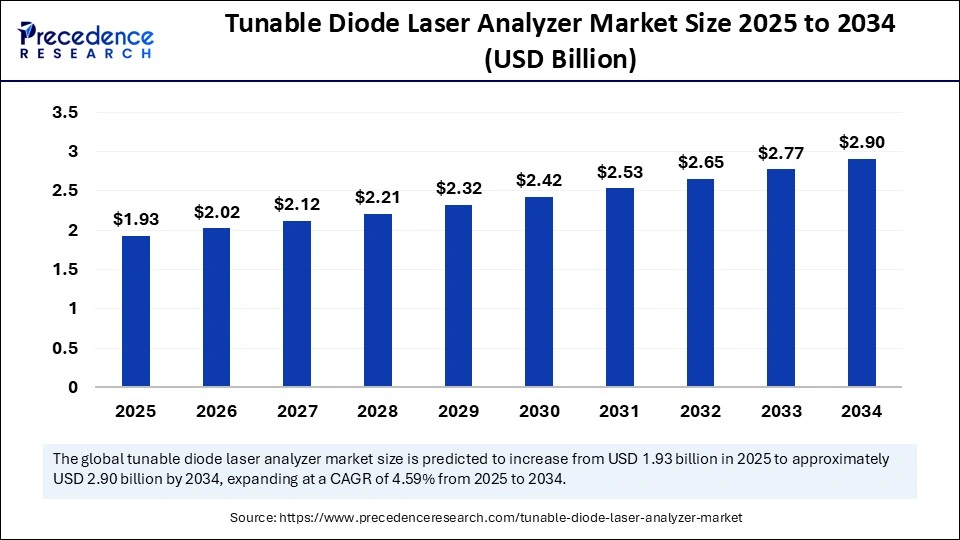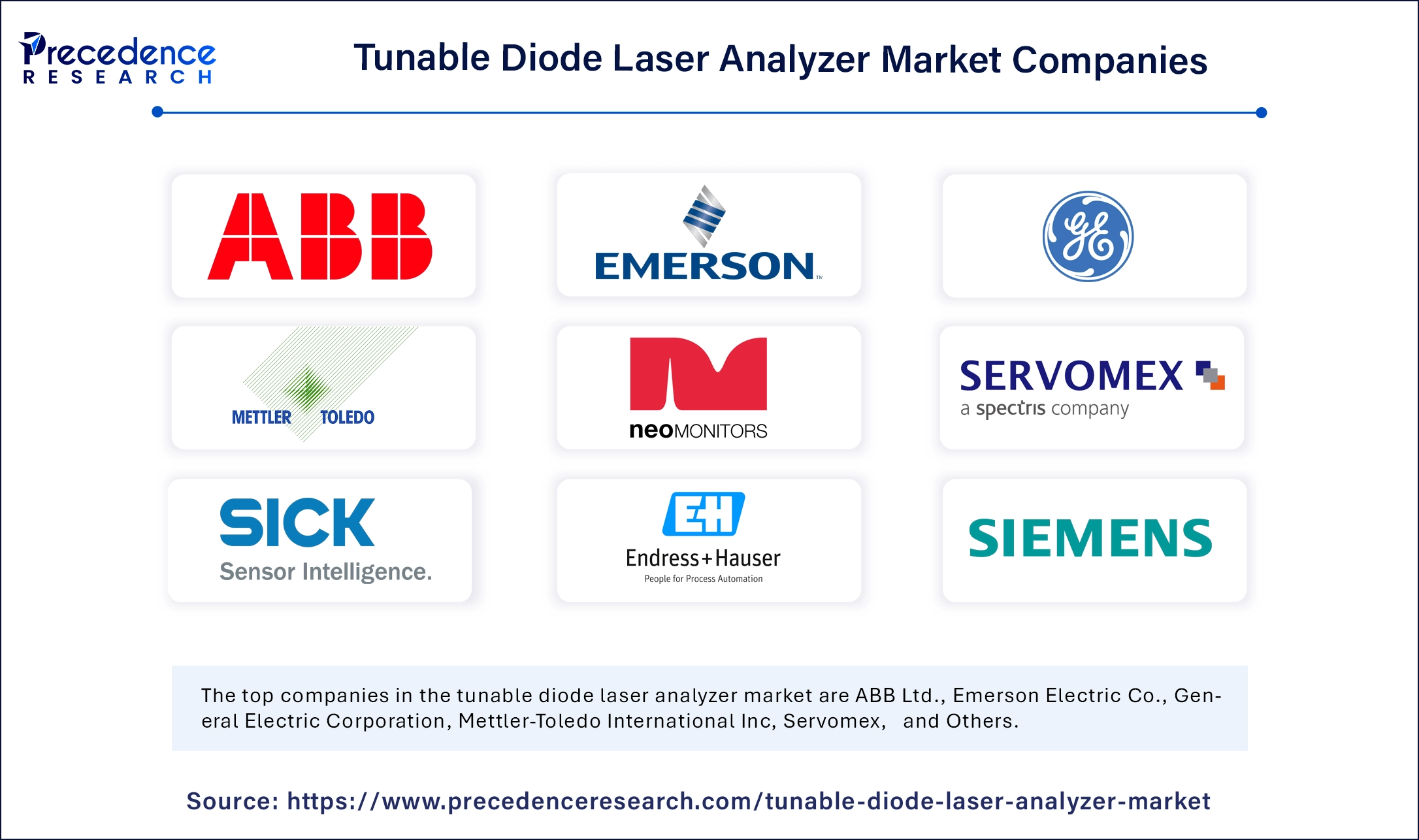December 2024
The global tunable diode laser analyzer market size is calculated at USD 1.93 billion in 2025 and is forecasted to reach around USD 2.9 billion by 2034, accelerating at a CAGR of 4.59% from 2025 to 2034. The North America market size surpassed USD 666 million in 2024 and is expanding at a CAGR of 4.74% during the forecast period. The market sizing and forecasts are revenue-based (USD Million/Billion), with 2024 as the base year.
The global tunable diode laser analyzer market size was calculated at USD 1.85 billion in 2024 and is predicted to increase from USD 1.93 million in 2025 to approximately USD 2.90 million by 2034, expanding at a CAGR of 4.59% from 2025 to 2034. The tunable diode laser analyzer is driven by rising demand for real-time, precise gas analysis and stringent environmental regulations.

Artificial intelligence (AI) delivers TDLA systems with significant advantages as a result of predictive maintenance, automated calibrating capabilities, and methods for real-time data analysis. The automated system can operate seamlessly. AI integration in the tunable diode laser analyzer market enables it to identify patterns and have remote control data monitoring periods by providing them greater functionality in sophisticated industrial applications.
The U.S. tunable diode laser analyzer market size was exhibited at USD 466.20 million in 2024 and is projected to be worth around USD 746.24mbillion by 2034, growing at a CAGR of 4.82% from 2025 to 2034.

North America accounted for the largest share of the tunable diode laser analyzer market in 2024. Environmental concerns and air quality problems fuel this market growth. Policies from governments and regulatory bodies trigger industries to adopt advanced monitoring technologies. The instruments achieve market success because they provide accurate measurement and real-time monitoring, and work effectively to monitor industrial spaces.
The United States functions as the largest customer base in North America. The environmental policies and rising sustainability focus have driven U.S. industries to adopt contemporary emission monitoring systems. Businesses operating in manufacturing, oil and gas, and chemical sectors invest in TDLAs as they need to fulfill regulatory requirements.
Asia Pacific is anticipated to witness the fastest growth in the tunable diode laser analyzer market during the forecasted years, due to the industrial growth at a fast rate and growing environmental awareness. The leading regions in this growth include China, India, Japan, and South Korea because these countries enforce strict emission control measures to stop air pollution and enhance air quality standards.

The adoption rate of the tunable diode laser analyzer market has grown substantially since it enables real-time analysis of gases without interference. Government-initiated air quality improvement programs in China have resulted in extensive implementation of continuous emission monitoring systems for industries where TDLS functions as their top selection technology. Both Japan and South Korea require their industries to establish clean technology investments as part of regulatory requirements.
Europe has emerged as a notable player in the global tunable diode laser analyzer market. Gas monitoring technology and industrial sustainability development occur through robust environmental regulations and industrial sustainability initiatives in industry applications. The region, including Germany, France, and the United Kingdom, is employed through its government to develop clean technologies while addressing emissions. European investments enable industrial infrastructure renewal and low-carbon economic transformation, which positively impacts the market.
A tunable diode laser analyzer (TDLA) operates as a precise measuring device to quantify gas concentrations in mixtures. Tunable diode laser absorption spectroscopy functions through an instrument that detects each gas based on its absorption wavelength. TDLA provides beneficial services to power generation, oil and gas, chemical, cement, healthcare, and metals industries through safety protection, regulatory compliance, and operational efficiency maintenance.
The enhanced global concern about environmental regulations leads industries to use gas analyzers for monitoring and managing emissions effectively. The need to optimize industrial processes in oil and gas, chemical, power generation, and cement industries increases TDLA system demand, since it the lower operational expenses while boosting production performance. Fast responsiveness, high sensitivity, and low maintenance requirements of TDLA systems make them suitable for combustible fumes monitoring systems and dangerous atmospheric gas sensing mechanisms in critical industrial environments.
| Report Coverage | Details |
| Market Size by 2034 | USD 2.9 Billion |
| Market Size in 2025 | USD 1.93 Billion |
| Market Size in 2024 | USD 1.85 Billion |
| Market Growth Rate from 2025 to 2034 | CAGR of 4.59% |
| Dominated Region | Asia Pacific |
| Fastest Growing Market | Europe |
| Base Year | 2024 |
| Forecast Period | 2025 to 2034 |
| Segments Covered | measurement type, industrial application, and Regions |
| Regions Covered | North America, Europe, Asia-Pacific, Latin America and Middle East & Africa |
Stringent environmental regulations
Government agencies around the world are making environmental safety a priority and are increasing regulations on pollution and climate controls because the public is generally more concerned about pollution and climate change. Industrial entities are using TDLA technology because new regulations require precision real-time detection for measurements of various gas concentrations. The strict emission regulations apply tremendous pressure on high-emission sectors that include the oil and gas, petrochemicals, and power generation facilities.
Organizations worldwide face environmental policies and global carbon reduction mandates, which lead them to spend on emission-controlling technologies and active responsibility measures. Government institutions and environmental protection agencies lead the market development through their commitment to promoting TDLA systems since they serve as crucial instruments for regulatory compliance and environmental accountability.
Rising demand for process optimization
Various power generation facilities, chemical plants, manufacturing facilities, and cement plants require accurate gas analysis to run their operations efficiently and at the lowest cost possible. The industry can use TDLAs for precise, in-moment gas analysis, which helps the industry maximize its combustion processes and reduce energy use and material waste. Organizations select system solutions that meet their operational efficiency and regulatory compliance needs. Demand for the tunable diode laser analyzer market will continue to be robust because the industrial sector needs to be streamlined, more productive, and to survive in a competitively harsh modern industry.
Calibration and maintenance
The most limiting factor of the tunable diode laser analyzer market is the rigor of periodic calibration and regular maintenance. Periodic calibration with certified gas mixtures is the largest technical barrier to TDLAs providing accurate and reliable performance, as it is a fundamental component of any maintenance procedures. Many maintenance functions need some specialized knowledge and maintenance expertise, such as beam alignment, debris removal, replacement of optical components, replacement of filters, etc., and fault detection, which require specialist capabilities, which smaller organizations do not have. Time for maintenance, cost of calibration, and specialist knowledge and skills continue to contribute to TDLA market constraints.
Industry focuses on sustainability
TDLA offers an accurate, real-time method of gas analysis that will be increasingly required for emissions monitoring and compliance as environmental regulations become more stringent. This increase in investment in clean operational infrastructure is a cause for significant investment in TDLAs in industries with the inclusion of TDLA into their operations as part of a sustainable operational environment. TDLA systems are firmly positioned as vital long-term solutions in attaining environmental and regulatory goals across several industries. This flexibility and versatility offer a significant growth opportunity for manufacturers and solutions providers.
The in-situ segment held a significant tunable diode laser analyzer market share in 2024. In-situ TDLAs further provide advantages by providing real-time measurement with high accuracy by measuring precisely where they occur in the process stream. An in-situ process analyzer operates directly in the process, so no sample extraction is needed, and the opportunity for sample contamination is greatly reduced.
Industries that produce energy, petrochemicals, cement, and metal processing sectors heavily rely on these analyzer systems. Companies experience improved safety, waste reduction, and better regulation of their environmental compliance through this method. The in-situ segment shows continuous expansion because organizations select quick, reliable, and efficient monitoring solutions for gases.
The oil and gas segment dominated the tunable diode laser analyzer market with the largest share in 2024. The vital role of TDLAs has emerged in the industry due to enhanced attention toward automated systems, environmental standards, and operational efficiency performance. Real-time gas concentration analysis is done in various stages of oil and gas operations within pipelines and storage facilities.
TDLAs provide leak detection and assure safety while optimizing process combustion owing to their accuracy and quick measurements. The oil and gas industry has stringent environmental regulations on greenhouse gas and methane emissions, and more advanced monitoring systems must be implemented.
The cement segment is anticipated to show substantial growth in the forecast period due to increasing environmental regulations and the sector’s commitment to emission reduction. The cement industry generates high carbon emissions that drive worldwide regulatory bodies to issue stricter mandatory environmental regulations to reduce the pollution footprint.
TDLAs enable plant facilities to observe fuel combustion response as well as emissions, which improve operational control while minimizing waste generation. Through its detection capabilities, TDLAs measure CO, CO2, NH3, and H2O gases in real-time for optimizing current processes and environmental surveillance, and need precise data.

By measurement type
By industrial application
By region
For inquiries regarding discounts, bulk purchases, or customization requests, please contact us at sales@precedenceresearch.com
No cookie-cutter, only authentic analysis – take the 1st step to become a Precedence Research client
December 2024
November 2024
November 2024
October 2024